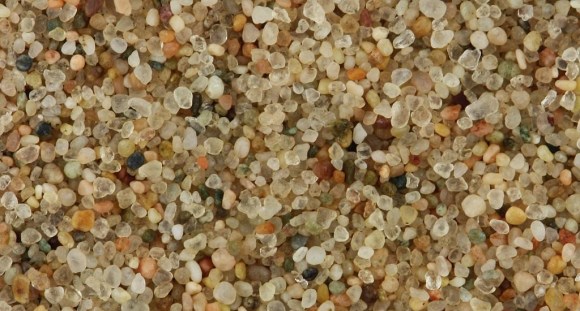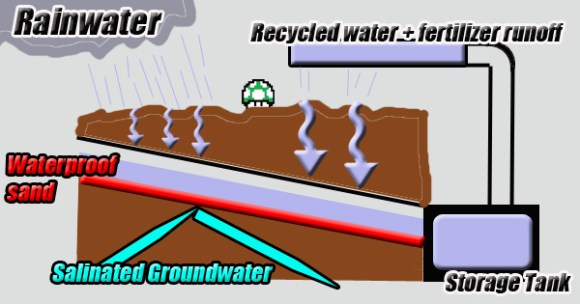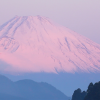
When you think of the multinational electronics producer Panasonic, “sand” probably doesn’t immediately come to mind. However, if a new product they are looking to release meets its full potential, this new kind of sand may completely change the face of the Earth as we know it.
The picture above is not Panasonic sand, but you wouldn’t be able to tell just by looking at it anyways. Actually even if you examine their grains of soil under a microscope you wouldn’t see a difference. So let’s start by looking at what makes this dirt so special and how it could help everyone in one way or another.
■ What is it?
Just so everyone’s on the same page, “sand” is simply soil defined by grain-sizes between 0.0625mm and 2mm. The actual material is largely irrelevant to be classified as sand. Panasonic sand is no different in this regard. What sets it apart, however, is that each grain has a special film around it to a thickness on the order of nanometers.
This substance effectively makes volumes of the sand waterproof by using the water’s surface tension to hold it together in a large mass rather than have it break down and seep through like it does with regular sand. Because this surface tension is unique to water, other substances like oxygen can still pass through freely. That might not sound like a lot, but the potential is huge.
■ What can it do?
In a test farm done by Panasonic with the help of the Kyoto University Graduate School of Agricultural Science they were able to increase the yield of a tomato crop by 40 percent. They did this by first creating a layer of waterproof sand between the ground water and topsoil. As water is added to the field it seeps down into the ground but is caught by the Panasonic sand before going too deep.
Since the waterproof sand layer was created on an incline, the water could be easily funneled into a reservoir to be used again on the same field. This process had an added benefit of recycling fertilizer rather than applying more thus cutting costs.
While this is great in a small field in Japan, the effects could really become something special in the ever-growing arid regions of the world. With little rainfall, it’s hard to grow anything of use, and in many places the groundwater is so high in salt that it acts like a sponge pulling away any water added from the surface before it can be used.
Panasonic sand not only blocks the fresh water from getting absorbed into the salt water but it can prevent the salt water from contaminating the fresh water allowing it to be reused for long periods of time. As a result the widespread usage of this sand could conceivably reverse the desertification of the world.
■ What’s the catch?
We don’t know, honestly. According to Panasonic this sand can be produced without any specialized equipment and cheaply. They say if produced locally, an area can get it for only a few thousand yen (a few dozen US dollars) per ton.
In addition, further applications have only just begun to come up. For example, senior researcher Norihisa Mino speculates it could be used to hold quantities of water under paved roads keeping them cool during the summer months and helping to curb urban heat islands.
The porous nature of Panasonic sand allows it to have less impact on the environment than other materials like concrete but also gives it potential in filtration systems. For example a desalinization plant could use it to process fresh water during times of shortage.
■ Why Panasonic?
An equally impressive thing about Panasonic sand is the example it sets for thinking outside the box. After all, from a company more known for its appliances and a head researcher who specializes in semiconductor manufacturing techniques, you’d hardly expect an agricultural game-changer.
The main ingredient of Panasonic sand was actually developed way back in 1994. Back then it was used as a protective film on the inside of rice cookers to prevent staining. Its success led to use on other products like microwave and toaster oven doors, but not much else from there. Still, Mino continued searching for something else that this stuff could be used on.
Years of looking came to a head when Mino consulted with Kyoto University and discovered its potential for agricultural use. The substance’s ability to both hold water and prevent salt damage piqued the interest of those in agronomy and work was underway.
We would say that the rest is history but really it’s the future. There is still testing to be done but if everything checks out we may see the once famous electronics company change to a completely different field after Panasonic celebrates its 100th anniversary in 2018.
Source: Sankei Biz (Japanese)
Top Image: Wikipedia – Siim Sepp


 Soak in a sand bath in Beppu, Japan’s famous onsen region
Soak in a sand bath in Beppu, Japan’s famous onsen region Chinese sand artist tickles the heartstrings of manga fans with stunning sand manga drawings 【Videos】
Chinese sand artist tickles the heartstrings of manga fans with stunning sand manga drawings 【Videos】 Panasonic to recognize same-sex marriages of its employees starting this April
Panasonic to recognize same-sex marriages of its employees starting this April Beautiful “sandy beach” near Nagasaki Airport is not made of sand…it’s made of glass!
Beautiful “sandy beach” near Nagasaki Airport is not made of sand…it’s made of glass! Can even our brown thumbs keep this “moss bonsai” kit alive?【Photos】
Can even our brown thumbs keep this “moss bonsai” kit alive?【Photos】 McDonald’s new Happy Meals offer up cute and practical Sanrio lifestyle goods
McDonald’s new Happy Meals offer up cute and practical Sanrio lifestyle goods All-you-can-drink Starbucks and amazing views part of Tokyo’s new 170 meter-high sky lounge
All-you-can-drink Starbucks and amazing views part of Tokyo’s new 170 meter-high sky lounge More foreign tourists than ever before in history visited Japan last month
More foreign tourists than ever before in history visited Japan last month Studio Ghibli glasses cases let anime characters keep an eye on your spectacles
Studio Ghibli glasses cases let anime characters keep an eye on your spectacles Beautiful Sailor Moon manhole cover coasters being given out for free by Tokyo tourist center
Beautiful Sailor Moon manhole cover coasters being given out for free by Tokyo tourist center We try out “Chan Ramen”, an underground type of ramen popular in the ramen community
We try out “Chan Ramen”, an underground type of ramen popular in the ramen community Starbucks reopens at Shibuya Scramble Crossing with new look and design concept
Starbucks reopens at Shibuya Scramble Crossing with new look and design concept Mister Donut ready to make hojicha dreams come true in latest collab with Kyoto tea merchant
Mister Donut ready to make hojicha dreams come true in latest collab with Kyoto tea merchant Japanese customer finds run-in with “Indian” convenience store clerk a refreshing experience
Japanese customer finds run-in with “Indian” convenience store clerk a refreshing experience Why is Japan such an unpopular tourist destination?
Why is Japan such an unpopular tourist destination? Disney princesses get official manga makeovers for Manga Princess Cafe opening in Tokyo
Disney princesses get official manga makeovers for Manga Princess Cafe opening in Tokyo Beautiful new Final Fantasy T-shirt collection on the way from Uniqlo【Photos】
Beautiful new Final Fantasy T-shirt collection on the way from Uniqlo【Photos】 Is the new Shinkansen Train Desk ticket worth it?
Is the new Shinkansen Train Desk ticket worth it? Foreign English teachers in Japan pick their favorite Japanese-language phrases【Survey】
Foreign English teachers in Japan pick their favorite Japanese-language phrases【Survey】 Japanese convenience store packs a whole bento into an onigiri rice ball
Japanese convenience store packs a whole bento into an onigiri rice ball Studio Ghibli releases Kiki’s Delivery Service chocolate cake pouches in Japan
Studio Ghibli releases Kiki’s Delivery Service chocolate cake pouches in Japan Japan’s bone-breaking and record-breaking roller coaster is permanently shutting down
Japan’s bone-breaking and record-breaking roller coaster is permanently shutting down New definition of “Japanese whiskey” goes into effect to prevent fakes from fooling overseas buyers
New definition of “Japanese whiskey” goes into effect to prevent fakes from fooling overseas buyers Our Japanese reporter visits Costco in the U.S., finds super American and very Japanese things
Our Japanese reporter visits Costco in the U.S., finds super American and very Japanese things Studio Ghibli unveils Mother’s Day gift set that captures the love in My Neighbour Totoro
Studio Ghibli unveils Mother’s Day gift set that captures the love in My Neighbour Totoro Foreign passenger shoves conductor on one of the last full runs for Japan’s Thunderbird train
Foreign passenger shoves conductor on one of the last full runs for Japan’s Thunderbird train Domino’s Japan now sells…pizza ears?
Domino’s Japan now sells…pizza ears? New Japanese KitKat flavour stars Sanrio characters, including Hello Kitty
New Japanese KitKat flavour stars Sanrio characters, including Hello Kitty Kyoto creates new for-tourist buses to address overtourism with higher prices, faster rides
Kyoto creates new for-tourist buses to address overtourism with higher prices, faster rides Sales of Japan’s most convenient train ticket/shopping payment cards suspended indefinitely
Sales of Japan’s most convenient train ticket/shopping payment cards suspended indefinitely Sold-out Studio Ghibli desktop humidifiers are back so Totoro can help you through the dry season
Sold-out Studio Ghibli desktop humidifiers are back so Totoro can help you through the dry season Japanese government to make first change to romanization spelling rules since the 1950s
Japanese government to make first change to romanization spelling rules since the 1950s Ghibli founders Toshio Suzuki and Hayao Miyazaki contribute to Japanese whisky Totoro label design
Ghibli founders Toshio Suzuki and Hayao Miyazaki contribute to Japanese whisky Totoro label design Doraemon found buried at sea as scene from 1993 anime becomes real life【Photos】
Doraemon found buried at sea as scene from 1993 anime becomes real life【Photos】 Tokyo’s most famous Starbucks is closed
Tokyo’s most famous Starbucks is closed One Piece characters’ nationalities revealed, but fans have mixed opinions
One Piece characters’ nationalities revealed, but fans have mixed opinions We asked a Uniqlo employee what four things we should buy and their suggestions didn’t disappoint
We asked a Uniqlo employee what four things we should buy and their suggestions didn’t disappoint Princesses, fruits, and blacksmiths: Study reveals the 30 most unusual family names in Japan
Princesses, fruits, and blacksmiths: Study reveals the 30 most unusual family names in Japan Researchers closing in on “Submersible Computers” that can be cooled in the ocean
Researchers closing in on “Submersible Computers” that can be cooled in the ocean It’s a race against time with Amazon Japan’s lowest-rated hourglass
It’s a race against time with Amazon Japan’s lowest-rated hourglass Grooming industry experts say an increasing number of Japanese men are shaving their pubic hair
Grooming industry experts say an increasing number of Japanese men are shaving their pubic hair Panasonic develops data communication using an ordinary light and smartphone
Panasonic develops data communication using an ordinary light and smartphone Japan’s ‘agri-tech’ farming revolution
Japan’s ‘agri-tech’ farming revolution Japanese soccer team fined 20 million yen because fans’ cheering violated COVID-19 guidelines
Japanese soccer team fined 20 million yen because fans’ cheering violated COVID-19 guidelines The future is here: Panasonic unveils interactive, transparent display at CES 2016
The future is here: Panasonic unveils interactive, transparent display at CES 2016 We try Starbucks Japan’s new sand dunes Frappuccino in Tottori
We try Starbucks Japan’s new sand dunes Frappuccino in Tottori Tokyo airport to test megaphone translator
Tokyo airport to test megaphone translator This man’s account of single-handedly digging his own well is oddly moving
This man’s account of single-handedly digging his own well is oddly moving A better use for your smartphone than Angry Birds: Remotely driving your car!
A better use for your smartphone than Angry Birds: Remotely driving your car! Beautiful Japanese cake looks like a slice of the ocean frozen in time【Photos】
Beautiful Japanese cake looks like a slice of the ocean frozen in time【Photos】 Do old eggs really float? We test this common “lifehack”
Do old eggs really float? We test this common “lifehack” Better than mosquito repellent – The most eco-friendly (and spiritual) way to repel pests in Japan
Better than mosquito repellent – The most eco-friendly (and spiritual) way to repel pests in Japan A week’s work on a Tibetan sand mandala, captured in eight mesmerizing minutes of video
A week’s work on a Tibetan sand mandala, captured in eight mesmerizing minutes of video
Leave a Reply